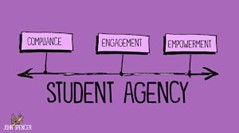News
Student empowerment: the role of the teacher in facilitating that students own their learning
Our job is not to prepare students for something. Our job is to help students prepare themselves for anything – A.J. Juliani
True empowerment of students, I came to realize, necessarily means a certain disempowerment of teachers – Eula Bliss
These quotes underscore the role of the teachers in student empowerment. During the recent Teaching and Learning Inspiration Days and a follow-up session, the Teaching Community (T@UU) took a deep dive into the topic of student empowerment.
The Teaching and Learning Inspiration Days is a biannual event where educators come together to participate in workshops, inspiration sessions, and roundtable discussions aimed at enhancing their teaching skills. Student empowerment emerged as a significant theme during one of our T@UU council meetings. We noticed that many teachers are already integrating student empowerment into their teaching, whether by involving students in course planning, allowing them to lead parts of lectures, or through other innovative methods.
Given the relevance and growing interest in this topic, we decided to host our first dedicated session on student empowerment. The session received an enthusiastic response, prompting us to organize a follow-up discussion. In this article, we’re excited to share the key insights and findings from these sessions.
What actually is student empowerment?
We would like to start this article with some scientific definitions of student empowerment. El-Amin (2022)[1] defines student empowerment as the process by which students obtain the ability to self-direct and action their own freedom of choice and decision-making in an academic setting. Student empowerment in the classroom is illustrated through the ability of an instructor to enable a student to learn, teach, and lead others through gaining a sense of power. In line, Hart, Blevins and Smith (2022)[2] define it as the student’s ability to possess the agency, power, and autonomy to make decisions in regards to their learning within the classroom.

In the academic literature on this topic, three general themes in defining student empowerment can be underscored: 1) agency for the students; they can decide on what happens and they have the power (although guided by the teacher) 2) There is an open atmosphere in the classroom, with a sense of community and 3) there is a (shared) responsibility for the learning process. Here, we highlight that empowerment is on a continuum of agency for students.
Examples of student empowerment
Taking these definitions in consideration, we discussed some examples in daily teaching of student empowerment with participants. We highlighted some ‘small’ initiatives and ‘large’ initiatives. Smaller initiatives are the more traditional or conventional methods of student empowerment, that can easily be part of existing curricula, such as: letting students decide on (some) course literature, letting students ‘host’ a part of a seminar or working in an interactive lab setting. Some more advanced forms include alternative ways for grading (e.g. students choose the grade they want to work for or grade themselves) and students designing their own course. These often lead to more challenges implementing this within the institutional design of programs or curricula.
Interactive discussion: challenges and opportunities in student empowerment
During our interactive sessions, we explored both the challenges and opportunities that arise when empowering students in the classroom. The participants of the workshop highlighted several recurring challenges:
- Challenges of student empowerment: When facilitating student empowerment, teachers at start face increased workload and time constraints, particularly when managing large groups of students. Grading becomes more complex, and there is a concern amongst some that the quality of education might be impacted. Additionally, empowering students requires a shift in control and can be difficult when students have varying levels of motivation and different learning styles. Teachers must also navigate the boundaries of the course content while allowing student-driven learning. Participants note it can lead to chaos and confusion because of a lot of different opinions as well that it is more difficult to (administrative) organize. Student empowerment can also present challenges in regard to diversity and inclusion; there is not one way that works for all students, some students are more active in class than others or one view on what is ‘good’ empowerment.
On the flip side, the opportunities presented by student empowerment are substantial, according to participants:
- Opportunities of student empowerment: empowered students tend to be more engaged, motivated, confident and active in their learning process. They become co-creators of their education, which creates ownership and can be more enjoyable for both students and teachers. This approach encourages shared responsibility, greater peer interaction, and can result in transformative learning experiences. Teachers also benefit by developing professionally and personally as they adapt to new teaching strategies.
To bring these opportunities into the classroom, we also discussed several practical strategies to make student empowerment work. These are some of the most often mentioned:
- Continuously engage with students about their needs and interests.
- Create a safe environment with a good (and positive) feedback system
- Implement challenge-based learning, where students define their own learning goals.
- Introduce self-grading or peer grading to foster responsibility.
- Allow students to choose their own issues, questions, and skills they wish to develop.
- Create alternative reading lists tailored to student interests.
- Consider using a flipped classroom model, where students take an active role in leading their learning journey.
These strategies aim to harness the benefits of student empowerment while addressing the challenges, creating a more dynamic and engaging learning environment.
We hope the sessions inspired some teaching staff further. If you are interested to learn more about student empowerment, don’t hesitate to contact us. If you have suggestions for the T@UU council to further work on this topic, please do let us know.
[1] El-Amin, A. (Ed.). (2022). Implementing diversity, equity, inclusion, and belonging management in organizational change initiatives. IGI Global.
[2] Hart, A. C., Blevins, B., & Smith, J. (2022). She Is Fierce: Examining Female Voice and Socratic Seminar. Enhancing Teaching and Learning With Socratic Educational Strategies: Emerging Research and Opportunities, 1-25.
 11 October 2024
11 October 2024
If you want to comment, please login on the left side of the page with your UU account..


